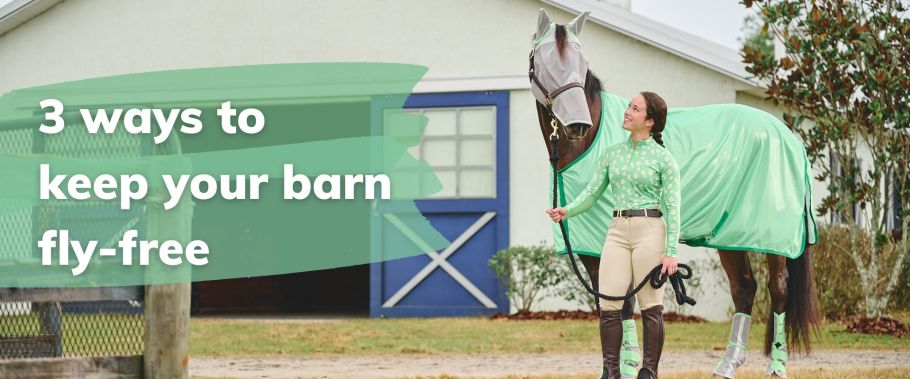3 ways to keep your barn fly-free




Fight Different Flies with Different Solutions
To defeat the enemy, we must first know the enemy, and while we all hate barns overrun with flies, do we even know which flies we're fighting? We've all heard of stable flies and house flies, but there's more than just those two species to consider when it comes to protecting our horses over the summer.
Biting flies like mosquitoes, black flies, midges, horse flies, and deer flies are known to feed on animal blood. Nonbiting flies feed on bodily secretions, from sweat to 'eye gunk' (or mucous), to the blood and tissue around open wounds. Which ones do you have at your barn? All of them? Only some of them?
If we don't know which bugs are bugging us, then we're probably not using the right solution to get rid of them.




Don't Overlook Smaller Breeding Grounds
The most common culprit is the manure pile, but did you know that the feed room, the wash stall, water buckets and troughs, and even the pond in the back field can be a welcoming area to common pests, too?
Knowing that our properties are full of areas of standing water isn't the same as knowing what to do about all that standing water, though. Unless we're rotating the buckets in every stall, emptying and refilling the troughs in every pasture, letting the wash stall full dry between uses, and somehow draining the pond out back, there's a good chance we're not getting rid of the problem.
Draining ponds? Daily bucket scrubbing? There are easier ways to keep all these smaller breeding areas from becoming big breeding areas, and we're going to talk about it.




Make the Biggest Problem More Manageable
We agree, the most common culprit for bug breeding grounds is anywhere manure sits, right? Right. But manure doesn't just pile up in But that's not just the muck pile, it's also the manure that sits in stalls, pastures, trails, and arenas. Any of these areas left un-mucked can make for an ideal environment for fly eggs and larvae to grow into full adult flies. And not only are there already ton of these spots across our properties, but every day our horses are adding more.
Short of having a team of poop-scoopers available around the clock and a manure-removal service stopping by daily, what can you do? It can feel overwhelming, all the issues buzzing around in your mind. So where are the solutions? You can address all the smaller issues in the barn and across your property, and it will help, but until you tackle the biggest (and smelliest), the pests will persist.


We're here to help you fight the flies in 3 key ways:




Help feed your horse's own personal no-fly zone.
There are two main types of insect control supplements you can add directly to your horse's grain:
- EPA-approved insect growth regulators help reduce the population. If you and your barn mates are ready to band together, you can look at feeding all the horses on the property an insect growth regulator, which can help ensure the manure in stalls, paddocks, and in the muck pile don't harbor breeding grounds for pests.
- Insect defense supplement make your horse unappealing to biting bugs. If you're looking for a more individual solution, pick an insect defense supplement to feed that can help give your horse his own personal no-fly zone by discouraging bugs from landing on him at all.




Prevent flies from developing before they can bother your horse.
Fly Stoppers™ are tiny, beneficial bugs. They stop adult pest flies from developing by feeding upon and breeding within the pupal stages of manure-breeding flies, making them an ideal choice for environmentally friendly fly control in stables. For the best fly control in your barn, release the Fly Stoppers in those breeding hot spots discussed above, such as manure piles and near standing water.




Use sprays to protect your horse from swishing and stomping.
Fly sprays and repellents can work in a few different ways. Most commonly, they can act as insecticides, which means that they're able to kill insects on contact. The other big solution is repel insects, discouraging flies from landing on your horse in the first place.
For a knockdown-and-don't-get-back-up effect, look for 'insecticide' sprays that use permethrin, pyrethroids, and/or pyrethrins. For a spray that repels insects, check ingredient labels peppermint, geraniol, and citronella. Don't forget to read the directions, too, as some sprays work best when applied before riding, after bathing, or on a certain cycle of days for the best results.



You're not alone in the battle against the bugs. Let us help you fight the flies on every front.
